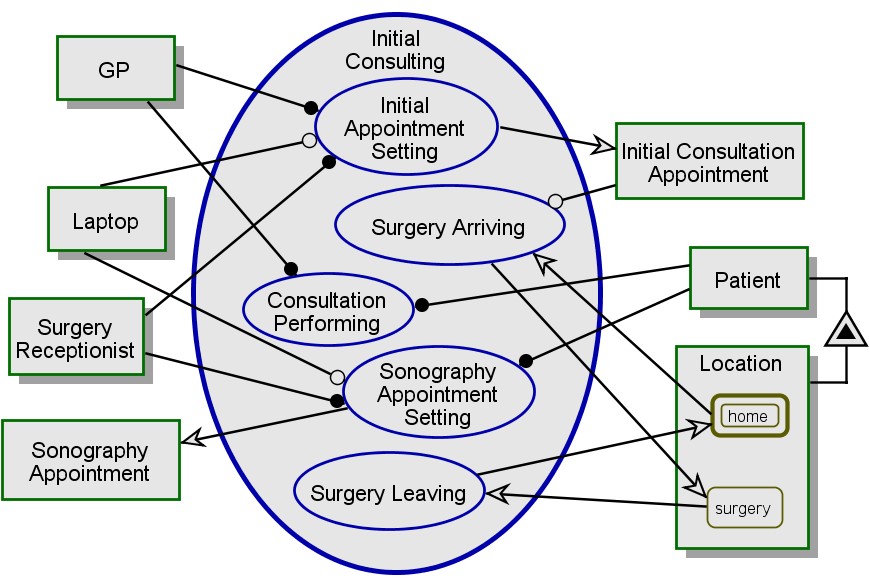Conceptual Model for four visualization applications |  |
Research action summary :
The aim of the project was to develop affordable servitisation business models based on the GE Vscan ultrasound for use in primary care. Being able to use the Vscan in this sector would permit to improve the patient experience and reduce costs for the protagonists of the primary care. Several objectives were set for this project:
- Review current processes for image capture between primary care and hospitals
- Develop a series of visualized servitization models
- Develop cost / benefit analysis for the range of possible business and service models
- Validate these models against current processes with end-users
- Explore the application of potential visualization technologies for PSS models
For visualizing, understanding, and communicating these business models, a visualisations were developed using OPM models. The first one permits to reduce the journey of the patient to one visit to the GP. The second validated business model is based on the services provided by a radiographer who visits the surgery on a weekly basis. The third business model is an extension of the second approach. However it requires a diagnostic radiographer qualified enough to analyse the images. Finally, in the fourth model, a mobile radiographer visits the patients at home. All four models were validated to be feasible, so a healthcare organization can pick what best fits its policy service model. Quantifying the cost of each model will enable finer optimisation of the model to be selected. In addition to its value for promoting affordable healthcare services, this JRA serves as a demonstrator of how OPM Object-Process Methodology (ISO 19450 Standard) can be utilised to effectively evaluate visualization technologies in general and those developed under VSIONAIR in particular. VISIONAIR has made notable contributions to healthcare.
The wide array of research domains and applications related to visualization is a clear demonstration of the success of VISIONAIR, to be a focus of knowledge in all aspects of visualization across Europe and a world-class center for visualisation technologies and research. VISIONAIR is continuing its journey in advancing the state-of-the art in visualization and dissemination of visualization-related knowledge to all the interested European researchers.
Research question :
The purpose of scientific visualization is to graphically illustrate scientific data to enable scientists to understand, illustrate, and glean insight from their data. Scientific visualisation is an interdisciplinary branch of science primarily concerned with the visualisation of three-dimensional phenomena (architectural, meteorological, medical, biological, etc.), where the emphasis is on realistic renderings of volumes, surfaces, illumination sources, and so forth, often with a dynamic (time) component. It is also considered a branch of computer graphics, which, in turn, is a branch of computer science.
In this JRA, we used physically small but complex system to demonstrate how OPM's Object-Process Methodology (ISO 19450 Standard) enables us to effectively communicate complex business models to potential end users, to enhance end user's comprehension of complex systems, and to evaluate visualization technologies by using the system approach. The OPM paradigm has been developed at Technion. OPM is a holistic graphical and textual methodology to represent and enhance comprehension of complex systems. OPM is based on system approach and has a rare ability to represent functional, structural and behavioral aspects of systems using a highly compact set of concepts in a single diagram type and equivalent natural language. Additional unique feature of OPM is the ability to translate a diagram representation into textual representation (English) on the fly The aim of the project described in this document is to adopt a systems approach to developing affordable models. The research questions of the W11.5 JRA were:
- How can visualization and interaction support Healthcare and improve the state-of-the-art?
- How can VISIONAIR supports Scientific Visualization and advance the state-of-the-art
Task and deliverables :
The Joint-Research-Activity Number 11.5 in Work Package 11 is related to the objectives from the DoW: Development of paradigms and environments that visualize OPM based conceptual models and enable their dynamic execution, research on visualization-related metaphors, ergonomics, usage, and social impact, develop and assess advanced visualization applications for collaboration, develop and assess scientific applications in chemistry, biology, and medicine. This action is related to task 11.1 in the DoW -task 11.1 Visualization of conceptual models and conceptual modelling. Within this task we develop a visual modeling paradigm that extends Object-Process Methodology (OPM). We evolve an OPM based conceptual model visual animation module that enables seeing the dynamics of the conceptual model in action concurrently at various levels of detail. Task 11.5 was reported in deliverable D11.5
Involved partners :
TECHNION, USALFORD, UCRANFIELD
Publications :
- Wachs, J. P., Frenkel, B., & Dori, D. (2014). Operation room tool handling and miscommunication scenarios: An object-process methodology conceptual model. Artificial Intelligence in Medicine. DOI: http://dx.doi.org/10.1016/j.artmed.2014.10.006.
- John Ahmet Erkoyuncu, Sergey Bolshchikov, Daniel Steenstra, Roy Rajkumar, Dov Dori, Constructing and Evaluating "as-is" and "to-be" OPM Models for the Healthcare sector for adoption of Vscan. Paper presented at the Conference on Systems Engineering Research (CSER'13), Georgia Institute of Technology, Atlanta, GA, March 19-22, 2013.
Related TNAs :
TNA with similar research questions was Project 6- A dynamic visual conceptual model for human-robot interaction for high risks high stakes scenarios.
Illustrations :
Figure 1 Pateint Treating in-zoomed. Shows both graphically Patient Treating in-zoomed, exposing the three main subprocesses: Initial Consulting, Ultrasound Imaging, and Follow-up Consulting.

Figure 2 Consulting in-zoomed. Shows both graphically (top) Initial Consulting in-zoomed, exposing five subprocesses.

.

VISIONAIR / Grenoble INP / 46 avenue Felix Viallet / F-38 031 Grenoble cedex 1 / FRANCE
Project funded by the European Commission under grant agreement 262044

Project funded by the European Commission under grant agreement 262044
